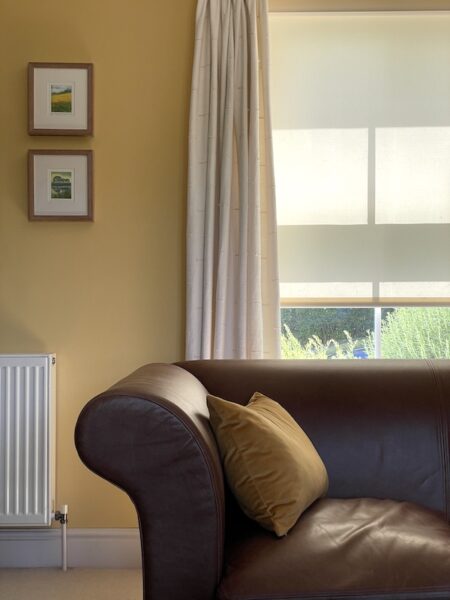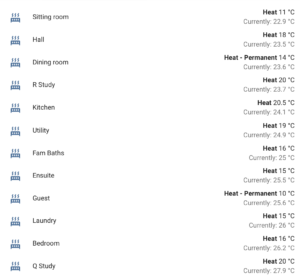 As we face record high temperatures in the UK today and tomorrow, it seems likely that climate change may bring us more of these in the future, so my first job over breakfast today was to write a little script for my Home Assistant-based home control system that sets all the blinds on the east- and south-facing windows to be 70% closed. We’ve never used them before to keep sunlight out in the middle of the day, but they work rather well.
As we face record high temperatures in the UK today and tomorrow, it seems likely that climate change may bring us more of these in the future, so my first job over breakfast today was to write a little script for my Home Assistant-based home control system that sets all the blinds on the east- and south-facing windows to be 70% closed. We’ve never used them before to keep sunlight out in the middle of the day, but they work rather well.
A bit later, as temperatures in my upstairs study were still getting rather high, I started to think about the radiators. Why? Well, we have smart thermostatic valves on all of them, which report back the temperature in each room. Normally, of course, this is so that each room can be heated to the right level for the time of day. (I have a separate schedule for each room, which is modified automatically based on things like whether there are guests in the guest room, or whether Rose’s phone is detected in her office in town rather than her study at home, or whether we’re watching TV in the evening.)
But I hadn’t really thought of making use of this data in the summer, until today, when I realised I could easily sort all my rooms in order of increasing temperature. A quick new view added to my control panel showed that yes, indeed, my study was currently the warmest room in the house, and the sitting room was the coolest:
So it would be much more sensible to go and work from the comfort of the sofa, rather than from my desk.
As a result, this comes to you from the sitting room, and I have successfully improved my comfort level. As you can tell, though, I don’t think it actually resulted in me doing more work…

Cool. Literally. I’ve been pondering buying either Tado or Shelly smart TRVs for the last 6 months. Tado is cheaper, but requires a working Internet connection. Shelly will integrate with Home Assistant, and I’ve already wired in a Shelly 1 to a few light switches. Any thoughts? Or have you gone for another brand?
Tado TRVs will also allow individual radiators to call for heat, whereas with Shelly, I’d need to script it and use https://github.com/bbqkees/ems-esp-domoticz-plugin or similar to adjust the boiler thermostat temperature. Sadly, I don’t have enough money for a heat-pump && PV && EV && battery storage, but comfort and reducing next winter’s bills is a priority.
I’ve had a Honeywell Evohome system since before I started using Home Assistant, and it all integrated nicely when I got deeper into automations, so that’s what I’ve used for, oh, it must be at least seven years now, I guess, and I’m a fan. I installed it myself in both the current house and the previous one, since it was only electrical changes, and I’m more confident of my abilities there than in the world of plumbing!
In my configuration, whenever one or more radiators calls for heat, the central-heating valve opens, and whenever either the CH or the hot water valve are open, the boiler turns on. (That latter bit is all pretty standard.)
Anyway, so I bought my kit from a plumbing company… but I am a fan of Shelly for other things…
For anyone coming back to this for more information, in the end, I went for Tado, for a couple of reasons
Firstly, native modulation support. This means fewer on/off cycles, more comfortable temperature control and increased efficiency (flow temperatures down to about 35 degrees Celsius when the house is almost heated). My Worcester Bosch boiler didn’t support OpenTherm, only their own proprietary EMS bus protocol. Tado supports this natively if you get the right wireless receiver (the EU version, not the UK version) or the wired thermostat. The Tado receiver has +36 volt connections, so it only required wiring 2 wires into the boiler, and means I could leave the existing receiver attached, so when I move house I can simply disconnect and leave the old (rubbish) thermostat for the next owner.
Secondly, I wanted a local connection to fall back on, as well as “cloud” support, in case vendor stops supporting it or starts charging for a subscription. Tado supports HomeKit natively, so if I want to by-pass the cloud control, or my Internet connection goes down, I can link it to HomeAssistant or my HomePod directly. I did look at the Drayton Wiser system, which has a local https web interface connection with HomeAssistant, but this would have required an OpenTherm to EMS converter (at ~£70 from Nefit). I believe the EvoHome can also be controlled locally if you buy a nanoCUL which transmits on 868MHz and uses an Arduino reverse-engineered interface. But I guess if you’ve got a reliable Internet connection, perhaps it’s not an issue if you’re worried about your data going into a vendor’s cloud somewhere.
I managed to buy 10 smart TRVs, a smart thermostat and receiver starter kit all in for less £500 (there were some good discounts for Quattro TRV packs in the summer) and got it wired in October. This past couple of weeks, with the temperatures down to -8 degrees overnight has been good testing. I’ve been averaging about 10m-cubed of methane consumption per day, so about ~£10 per day for a large 1970s-era 4 bedroom house, with upstairs off during the day, and downstairs off at night. This has meant I could keep my wife warm without worrying so much about the current extortionate energy costs!
You can read more technical details here: https://community.tado.com/en-gb/discussion/comment/49793#Comment_49793
Our master bedroom, with 4 outside walls, when it’s -8 degrees outside, requires continual heat overnight to keep it at 16.5 degrees, at a flow temperature of 48 degrees. The other bedrooms require the radiator TRV to activate every 30 mins, or for the smallest room, about once an hour. As you’ll see from the final screen shot, you can see the reduction in gas usage since the temperature has returned to a more usual +6 degrees at night.
Well done, Jonathan! Interesting stuff. I’ve never looked very closely at boilers before; have only considered them as binary relay-controlled devices. There’s clearly a whole new world to discover when I get my next one!
And I also hadn’t discovered the options for local control of my Evohome system. Very tempted to play with that, though the remote API has always been exceedingly reliable, if not super speedy.
Many thanks!